Discover comprehensive Class 10 Biology notes on Chapter 7 "How Do Organisms Reproduce?" Explore the diverse methods of reproduction in the plant and animal kingdom, from budding to sexual reproduction. Enhance your understanding of life's fundamental processes with our concise and informative blog post. Delve into the intricate world of reproduction and unlock the secrets of life's continuity. Read now!
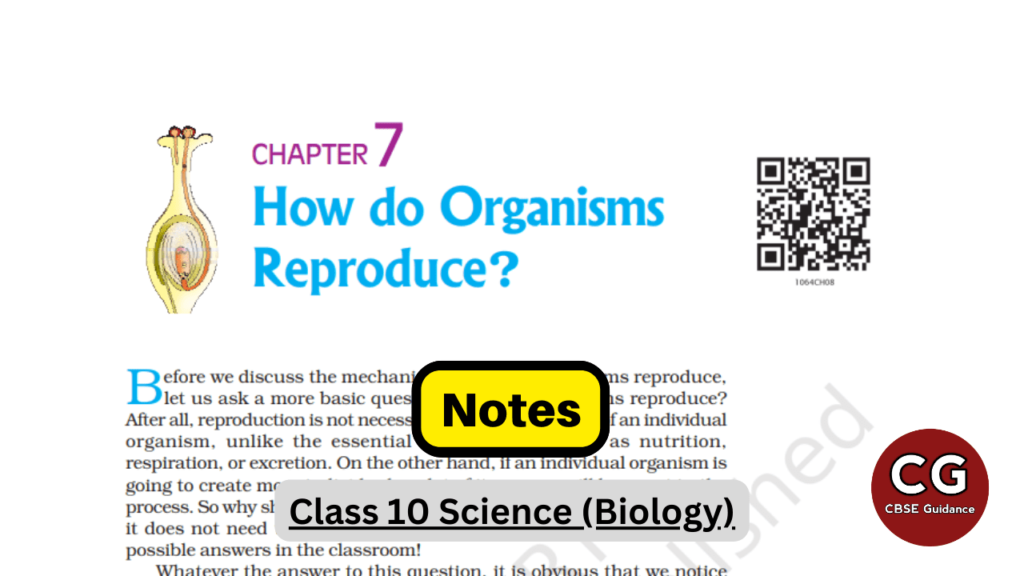
| Subject | Science (Biology) |
| Class | 10 |
| Board | CBSE & State Boards |
| Chapter No. | 7 |
| Chapter Name | How do Organisms Reproduce? |
| Type | Notes |
| Session | 2024-25 |
"The difference between ordinary and extraordinary is that little extra."
- Jimmy Johnson
How do Organisms Reproduce? Class 10 Notes
Table of Contents
Need for Reproduction:
- Organisms need energy for survival which they obtain from life processes such as nutrition and respiration.
- Reproduction does not provide energy. It needs a lot of energy.
- Genetic material is transferred from one generation to the next as a result of reproduction through DNA copying.
- DNA copying takes place with high constancy and considerable variations, which is advantageous to the species for stability in the changing environment.
Variation and its Importance:
Variation is important for the survival of a species but can sometimes be harmful to an individual because:
- Adapting to change: Variations make the population diverse, meaning some individuals might have traits that help them survive if the environment changes.
- Helping evolution: Over time, helpful variations can build up in the population, leading to new species that are better suited to their environment.
- Risk to individuals: Although variation helps the species, some changes might not be good for an individual in their specific environment, which could make it harder for them to survive.
Modes of Reproduction Used by Single Organisms
i. Fission
For unicellular organisms, cell division, or fission, leads to the creation of new individuals.
| Feature | Binary Fission | Multiple Fission |
| Number of daughter cells | Two | Many |
| Division process | Parent cell divides into two equal halves | Parent cell divides into multiple daughter cells simultaneously |
| Examples | Many bacteria and protozoa like Amoeba, Paramecium, and Leishmania. | Plasmodium (malarial parasite). |
| Speed of division | Relatively faster | Relatively slower |
| Complexity | Simpler | More complex |
| Diagram | iv. 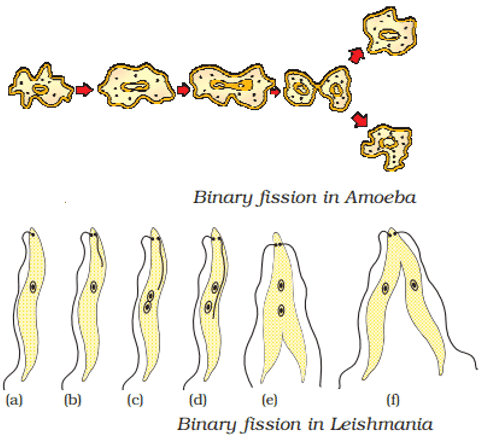 | iv. 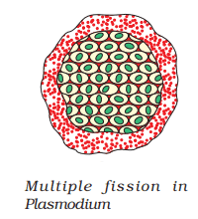 |
ii. Fragmentation
In multi-cellular organisms with relatively simple body organization, simple reproductive methods can still work. Spirogyra, for example, simply breaks up into smaller pieces upon maturation. These pieces or fragments grow into new individuals.
It is not possible to reconstruct the whole organism from a fragment in complex multicellular organisms because many multi-cellular organisms are not simply a random collection of cells. Specialized cells are organized as tissues and tissues are organized into organs, which then have to be placed at definite positions in the body. Therefore, the cell-by-cell division would be impractical.
iii. Regeneration
Many fully differentiated organisms have the ability to give rise to new individual organisms from their body parts. That is, if the individual is somehow cut or broken up into many pieces, many of these pieces grow into separate individuals. For example, simple animals like Hydra and Planaria can be cut into any number of pieces and each piece grows into a complete organism. This is known as regeneration.
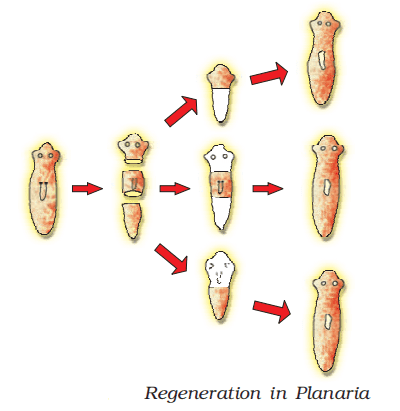
iv. Budding
In Hydra, a bud develops as an outgrowth due to repeated cell division at one specific site. These buds develop into tiny individuals and when fully mature, detach from the parent body and become new independent individuals. Yeast also follows budding for reproduction.
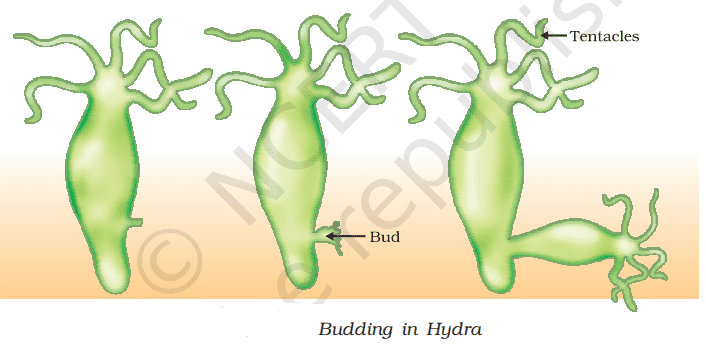
v. Vegetative Propagation
The method of producing new plants from vegetative parts like roots, stems, and leaves are called vegetative propagation.
Buds produced in the notches along the leaf margin of Bryophyllum fall on the soil and develop into new plants.
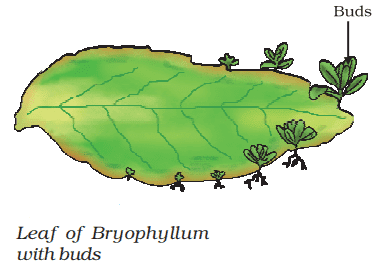
The advantages of vegetative propagation are:
- Faster growth and earlier flowering and fruiting.
- Preservation of desired traits.
- Propagation of seedless varieties.
Disadvantages of vegetative propagation are:
- Such plants are genetically similar to parent plants and are vulnerable to infections and diseases.
- They do not have variations, therefore, do not adapt well to changing environments, and the plant species do not evolve.
vi. Spore Formation
The thread-like structures that develop on bread are the hyphae of the bread mould (Rhizopus). They are non-reproductive parts. The tiny blob-on-a-stick structures are involved in reproduction. The blobs are sporangia, which contain cells, or spores, that can eventually develop into new Rhizopus individuals.
Advantages of spore formation:
- Survival in Harsh Conditions: Spores are highly resistant to extreme conditions like heat, cold, and drought. This helps the organism survive unfavorable environments.
- Wide Dispersal: Spores are lightweight and can easily be carried by wind, water, or animals to distant places. This increases the chances of colonizing new environments.
- Rapid Population Increase: Spores are produced in large numbers, ensuring that even if many are destroyed, some will still survive and grow into new organisms.
Advantages of the asexual mode of reproduction
- Only one individual is required.
- Progeny is identical to parents.
- Produced in large numbers.
Sexual Reproduction
It is a mode of reproduction that depends on the involvement of two individuals before a new generation can be created.
Four steps in sexual reproduction:
- Formation of gametes in the sex organs.
- Transfer of male gamete to female gamete.
- Fusion of gametes, either inside or outside the female parent's body.
- Development of the zygote to embryo and then complete individual.
Advantages of sexual reproduction:
- Variations are produced among the progeny.
- Such populations are able to adapt well to changing environment and thus evolves faster.
| Asexual reproduction | Sexual reproduction |
| i. Involves only one parent. | i. It involves two parents. |
| ii. Gametes are not produced. | ii. Gametes are produced. |
| iii. No fertilization and zygote formation. | iii. Fertilization and zygote formation is observed. |
| iv. Produces offspring less rapidly. | iv. Produces offspring more rapidly. |
Sexual Reproduction in Flowering Plants
Different parts of a flower are – sepals, petals, stamens, and pistils. The stamens and pistils are the reproductive parts of a flower that contain the germ cells.
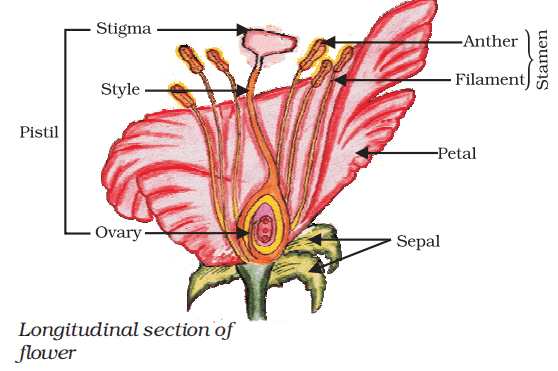
The flower may be
- unisexual (papaya, watermelon) when it contains either stamens or pistils
- bisexual (Hibiscus, mustard) when it contains both stamens and pistils.
- Stamen is the male reproductive part and it produces pollen grains that are yellowish in colour.
- Pistil is present in the center of a flower and is the female reproductive part. It is made of three parts: stigma, style, and ovary.
- The ovary contains ovules and each ovule has an egg cell.
- The male germ cell produced by pollen grain fuses with the female gamete present in the ovule.
- This fusion of the germ cells or fertilization gives us the zygote which is capable of growing into a new plant.
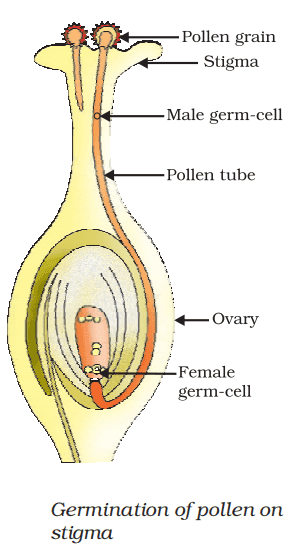
| Pollination | Fertilization |
| i. It is the transfer of pollen grain from the anther to the stigma of a flower. | i. It is the fusion of the male gamete with the female gamete. |
| ii. It is achieved by agents like wind, water, or animals. | ii. It is achieved by the growth of the pollen tube so that the male gamete reaches the female germ cells. |
| iii. It leads to fertilization. | iii. It leads to the formation of seeds. |
| iv. It is an external process. | iv. It is an internal process. |
Process of seed formation in a flowering plant:
- The pollen from the stamen is transferred to the stigma.
- The male germ cell and the female germ cells combine to form the zygote.
- The zygote undergoes rapid division to form the embryo inside the ovule.
- The ovule develops a seed coat and turns into a seed.
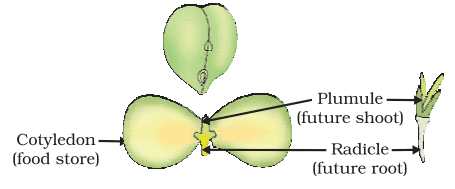
| Self-pollination | Cross-pollination |
| i. It is the transfer of pollen grains from the anther to the stigma within the same flower. | i. It is the transfer of pollen grains from the anther to the stigma in another flower. |
| ii. It occurs either in the same flower or another flower of the same plant. | ii. It occurs between two flowers that are on different plants but are of the same species. |
| iii. It occurs in flowers that are genetically the same. | iii. It occurs between flowers that are genetically different. |
Reproduction in Human Beings
- The ratio of number of chromosomes between an egg and its zygote is 1:2.
- Sperms contain either X or Y chromosomes whereas an egg will always have an X chromosome.
| General Growth | Sexual Maturation |
| General growth refers to different types of developmental processes in the body like an increase in height, weight gain, and changes in shape and size of the body. | Sexual maturation is specific to changes reflected at puberty like the cracking of voice, new hair patterns, development of breasts in females, etc. |
Sexual maturation of reproductive tissues is a necessary link for reproduction because of the need for specialized cells called germ cells to participate in sexual reproduction. The body of the individual organism has to grow to its adult size, the rate of general body growth begins to slow down, and reproductive tissues begin to mature.
A whole new set of changes in the appearance of the body takes place like changes in body proportions, and new features appear. This period during adolescence is called puberty.
There are also changes taking place that are different between boys and girls. In girls, breast size begins to increase, with darkening of the skin of the nipples at the tips of the breasts. Also, girls begin to menstruate at around this time. Boys begin to have new thick hair growth on their faces and their voices begin to crack.
Male Reproductive System
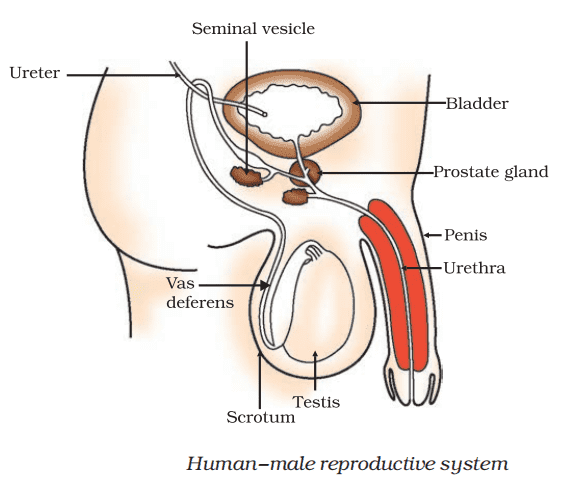
- The urethra serves as a common passage for both sperm and urine.
- The testosterone hormone is released by the testis. In addition to regulating the formation of sperm, testosterone brings about changes in appearance seen in boys at the time of puberty.
- The prostate gland and the seminal vesicles add their secretions so that the sperms are now in a fluid which makes their transport easier and this fluid also provides nutrition.
Female Reproductive System
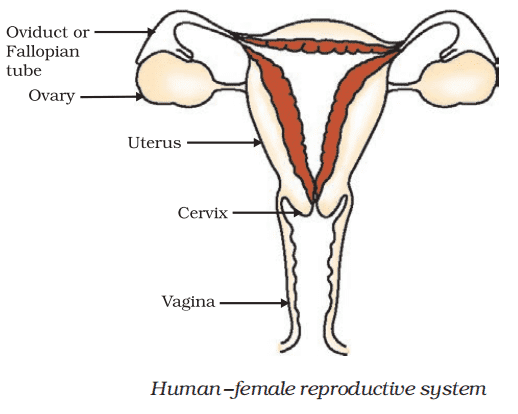
- Ovary (production of egg)
- Oviduct (site of fertilization)
- Uterus (site of implantation)
- Vagina (entry of the sperm)
Functions of the ovary:
- Production of the female hormone estrogen.
- Production of female gamete.
Functions of Oviduct/Fallopian tube:
- Transfer of female gamete from the ovary.
- Site of fertilization.
Functions of the uterus:
- Implantation of the zygote.
- Nourishment of developing embryo.
Placenta: A placenta is a special tissue connection between the embryo and the uterine wall.
Role of the Uterus and Placenta in the Growth and Development of the Embryo:
- The lining of the uterus thickens and is richly supplied with blood to nourish the growing embryo.
- The embryo gets nutrition from the mother’s blood with the help of the placenta. It is embedded in the uterine wall.
- It contains villi on the embryo’s side of the tissue. On the mother’s side are blood spaces, which surround the villi.
- This provides a large surface area for nutrition and oxygen to pass from the mother to the embryo.
- Waste substances produced by the embryo are removed through the placenta into the mother’s blood.
- The child is born as a result of rhythmic contractions of the muscles in the uterus.
When the egg is not fertilized:
- The egg survives for a day in the reproductive system.
- In case the egg is not fertilized, it is shed along with the lining of the uterus out of the vagina as blood and mucus.
Child marriages are a hazard to women's reproductive health because:
- Females will not have reached full sexual maturity at the time of marriage.
- There are possibilities of pregnancy in the teenage years that may cause adverse effects on the female’s body.
Contraceptive methods are used such as:
- Mechanical barriers (condoms)
- Drugs (as pills)
- Loop or copper T
- Surgical method.
Pills change the hormonal balance and thus prevent the release of the egg, hence fertilization is prevented. But this method can have some side effects as it interferes with the hormonal balance of the body.
Advantages of using a mechanical barrier over other contraceptive measures:
- Contraceptive pills can cause hormonal imbalances.
- Copper T and IUD can cause irritation to the uterine lining if not placed correctly.
- Surgical methods, if not performed properly, can lead to infections and complications.
Download Class 10 Science Chapter 7 How do Organisms Reproduce? NCERT Underlined PDF
| Must Read: How do Organisms Reproduce Class 10 Important Questions Answers Control and Coordination Class 10 Important Questions with Answers |
| You Might Also Like: CBSE Class 10 Notes CBSE Class 10 Important Questions and Answers |
Hope you liked these notes on Class 10 Science Chapter 7 How Do Organisms Reproduce? Please share this with your friends and do comment if you have any doubts/suggestions to share.
Sir,
In this notes you not include any important diagram like reproduction in Amoeba, Plasmodium, budding in yeast etc.
Sir, please include important diagram for board examination.
Thanku
Draw from reference book/ ncert. Book
These all notes are really very helpful..I scored 70+ in sci out of 100